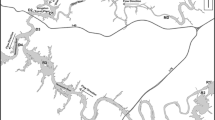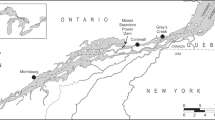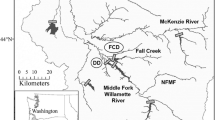Abstract
Imposex and decline in reproductive output in marine gastropods have been linked to tributyltin (TBT) exposure. This study describes Chesapeake Bay, USA, veined rapa whelk Rapana venosa imposex incidence and sex ratios from 1998 to 2009. Tissue TBT concentrations (ng g−1) were examined with respect to whelk sex, size, and water temperature at the time of collection, and also to egg case size, hatching success, and veliger diameter. Imposex incidence declined and population sex ratios moved closer to parity from 1998 to 2009. Observed TBT concentrations (ng g−1) were higher in James River than in Ocean View whelks with higher TBT concentrations observed in males than in females. Exponential declines in TBT concentrations from female-specific first to last clutches within a reproductive season were observed, indicating that whelks depurate TBT through egg case deposition. Egg capsule hatching success and veliger size were similar for female and imposex whelks. The R. venosa imposex levels observed in Chesapeake Bay apparently do not affect the production, release, or viability of larvae.







Similar content being viewed by others
References
Amio M (1963) A comparative embryology of marine gastropods with ecological considerations. Bull Shimonoseki Univ Fish 12:15–143
Barreiro R, Gonzalez R, Quintela M, Ruiz JM (2001) Imposex, organotin bioaccumulation and sterility of female Nassarius reticulatus in polluted areas of NW Spain. Mar Ecol Prog Ser 218:203–212
Bright D, Ellis D (1990) A comparative survey of imposex in northeast Pacific neogastropods (Prosobranchia) related to tributyltin contamination, and choice of a suitable bioindicator. Can J Zool 68:1915–1924
Bryan G, Gibbs P, Huggett R, Curtis L, Bailey D, Dauer D (1989) Effects of tributyltin pollution on the mud snail, Ilyanassa obsoleta, from the York River and Sarah’s Creek, Chesapeake Bay. Mar Pollut Bull 20:458–462
Bryan G, Burt G, Gibbs P, Pascoe P (1993) Nassarius reticulatus (Nassariidae: Gastropoda) as an indicator of tributyltin pollutin before and after TBT restrictions. J Mar Biol Assoc UK 73:913–929
Burkenroad M (1931) Notes on the Louisiana conch, Thais haemastoma, Linn., in its relation to the oyster Ostrea virginica. Ecology 12:656–664
Butler P (1954) The southern oyster drill. Proc Natl Shellfish Assoc 44:67–75
Carriker M (1954) Seasonal vertical movements of oyster drills. Proc Natl Shellfish Assoc 45:190–198
Carriker M (1955) Critical review of biology and control of oyster drills Urosalpinx and Eupleura. Special Scientific Report: Fisheries No. 148, US Department of the Interior, Fish and Wildlife Service
Chung E, Kim S (1997) Cytological studies on testicular maturation and cyclic changes in the epithelial cells of the seminal vesicle of the male purple shell, Rapana venosa (Gastropoda: Muricidae). Malacol Rev 30:25–38
Chung E, Kim S, Kim Y (1993) Reproductive ecology of the purple shell Rapana venosa (Gastropoda: Muricidae), with special reference to the reproductive cycle, depositions of egg capsules, and hatchings of larvae. Korean J Malacol 9:1–15
Chung E, Kim S, Park K, Park G (2002) Sexual maturation, spawning, and deposition of the egg capsules of the female purple shell, Rapana venosa (Gastropoda: Muricidae). Malacologia 44:241–257
D’Asaro C (1966) The egg capsules, embryogenesis, and early organogenesis of a common oyster predator, Thais haemastoma floridana (Gastropoda: Prosobranchia). Bull Mar Sci 16:884–914
Davis M (1994) Mariculture techniques for queen conch (Strombas gigas L.): Egg mass to juvenile stage. In: Appledoorn R, Rodriguez B (eds) Queen conch biology, fisheries, and mariculture. Fundacion Cientifica Los Roques, Caracas, Venezuela, pp 231–252
Dowson P, Bubb J, Lester J (1996) Persistence and degradation pathways of tributyltin in freshwater and estuarine sediments. Est Coast Shelf Sci 42:551–562
Evans D, Huggett R (1991) Statistical modeling of intensive TBT monitoring data in two tidal creeks of the Chesapeake Bay. Mar Environ Res 32:169–186
Evans S, Leksono T, McKinnell P (1995) Tributyltin pollution: a diminishing problem following legislation limiting the use of TBT-based anti-fouling paints. Mar Pollut Bull 30:14–21
Feare C (1970) The reproductive cycle of the dog whelk (Nucella lapillus). Proc Malacol Soc Lond 39:125–137
Federighi H (1931) Studies on the oyster drill (Urosalpinx cinerea, Say). Bull Bur Fish US 47:83–115
Fernandez M, de Luca Rebello Wagener A, Limaverde A, Scofield A, Pinheiro F, Rodrigues E (2005) Imposex and surface sediment speciation: a combined approach to evaluate organotin contamination in Guanabara Bay, Rio de Janeiro, Brazil. Mar Environ Res 59:435–452
Fish J, Fish S (1996) A student’s guide to the seashore, 2nd edn. Cambridge University Press, New York
Franz D (1971) Population age structure, growth, and longevity of the marine gastropod Urosalpinx cinerea Say. Biol Bull 140:63–72
Gibbs PE (1996) Oviduct malformation as a sterilising effect of tributyltin (TBT) induced imposex in Ocenebra erinacea (Gastropoda: Muricidae). J Moll Stud 62:403–413
Gibbs PE, Bryan GW (1987) TBT paints and the demise of the dog-whelk, Nucella lapillus (Gastropoda). In: Proc Oceans ‘87 Int Organotin symp, vol 4, IEEE, Piscataway, NJ, USA, pp 1482–1487
Gibbs PE, Bryan GW (1996) Reproductive failure in the gastropod Nucella lapillus associated with imposex caused by tributyltin pollution: a review. In: Champs MA, Seligman PF (eds) Organotin: environmental fate and effects. Chapman and Hall, New York, pp 259–280
Gibbs PE, Bryan GW, Pascoe P, Burt GR (1987) The use of the dog-whelk, Nucella lapillus, as an indicator of tributyltin (TBT) contamination. J Mar Biol Ass UK 67:507–523
Gibbs PE, Pascoe PL, Burt GR (1988) Sex change in the female dog whelk Nucella lapillus induced by tributyltin from antifouling paints. J Mar Biol Assoc UK 68:715–731
Gibbs PE, Bryan GW, Pascoe PL, Burt GR (1990) Reproductive abnormalities in female Ocenebra erinacea (Gastropoda) resulting from tributyltin induced imposex. J Mar Biol Assoc UK 70:639–656
Gibbs PE, Bryan GW, Pascoe PL (1991a) TBT-induced imposex in the dogwhelk, Nucella lapillus: geographical uniformity of the response and effects. Mar Environ Res 32:79–87
Gibbs PE, Spencer B, Pascoe P (1991b) The American oyster drill, Urosalpinx cinerea (Gastropoda): evidence of decline in an imposex-affected population (R. Blackwater, Essex). J Mar Biol Assoc UK 71:827–838
Harding JM (2006) Growth and development of veined rapa whelk Rapana venosa veligers. J Shellfish Res 25:941–946
Harding JM, Mann R (1999) Observations on the biology of the veined rapa whelk, Rapana venosa (Valenciennes, 1846) in the Chesapeake Bay. J Shellfish Res 18:9–17
Harding JM, Mann R, Ware-Kilduff C (2007) The effects of female size on fecundity in a large marine gastropod Rapana venosa (Muricidae). J Shellfish Res 26:33–42
Harding JM, Mann R, Kilduff C (2008) Influence of environmental factors and female size on reproductive output in a temperate invasive marine gastropod Rapana venosa (Muricidae: Valenciennes 1846). Mar Biol 155:571–581
Harding JM, Trapiani CM, Walton W, Frick M, Mann R (2011) Sea turtles as potential dispersal vectors for non-indigenous species: the veined rapa whelk as an epibiont of loggerhead turtles. Southeast Nat 10:233–244
Huggett RJ, Evans DA, MacIntyre WG, Unger MA, Seligman PF, Hall LW Jr (1996) Tributyltin concentration in waters of the Chesapeake Bay. In: Champ MA, Seligman PF (eds) Tributyltin: environmental fate and effects. Chapman and Hall, New York, pp 485–502
Ide I, Witten E, Fisher J, Kalbfus W, Zellner A, Stroben E, Watermann B (1997) Accumulation of organotin compounds in the common whelk Buccinum undatum and the red whelk Neptunea antiqua in association with imposex. Mar Ecol Prog Ser 152:197–203
Jestel EA (2002) Imposex as an indicator of butyltin exposure in the veined rapa whelk (Rapana venosa): a Chesapeake Bay invader. MS thesis, Virginia Institute of Marine Science, The College of William & Mary, Gloucester Point
Knickmeyer R, Steinhart H (1990) Seasonal variations and sex related differences of organochlorines in whelks (Buccinum undatum) from the German bight. Chemosphere 20:109–122
Limaverde A, Wagener A, Fernandez M, Scofield A, Coutinho R (2007) Stramonita haemastoma as a bioindicator for organotin contamination in coastal environments. Mar Environ Res 64:384–398
Luckenbach MW, O’Beirn FX, Taylor J (1999) An introduction to culturing oysters in Virginia. Virginia Institute of Marine Science, Gloucester Point
Mann R, Harding JM (2000) Invasion of the North American Atlantic coast by a large predatory Asian mollusc. Biol Inv 2:7–22
Mann R, Harding JM (2003) Salinity tolerance of larval Rapana venosa: implications for dispersal and establishment of an invading predatory gastropod on the North American Atlantic coast. Biol Bull 204:96–103
Mann R, Harding JM, Westcott E (2006) Occurrence of imposex and seasonal patterns of gametogenesis in the invading veined rapa whelk Rapana venosa from Chesapeake Bay, USA. Mar Ecol Prog Ser 310:129–138
Mensink B, Everaarts JM, Kralt H, ten Hallers-Tjabbes C, Boon J (1996) Tributyltin exposure in early life stages induces the development of male sexual characteristics in the common whelk Buccinum undatum. Mar Environ Res 42:151–154
Mensink BP, Kralt H, Vethaak AD, ten Hallers-Tjabbes CC, Koeman JH, van Hattum B, Boon JP (2002) Imposex induction in laboratory reared juvenile Buccinum undatum by tributyltin (TBT). Environ Toxicol Pharmacol 11:49–65
Nicholson G, Evans S (1997) Anthropogenic impacts on the stocks of the common whelk (Buccinum undulatum (L.). Mar Environ Res 44:305–314
Oehlmann J, Stroben E, Fioroni P (1992) The rough tingle Ocenebra erinacea (Gastropoda: Muricidae): an exhibitor of imposex in comparison to Nucella lapillus. Helgolander Meeresun 46:311–328
Pearce JB, Thorson G (1967) The feeding and reproductive biology of the red whelk, Neptunea antiqua (L.) (Gastropoda, Prosobranchia). Ophelia 4:277–314
Poloczanska ES, Ansell AD (1999) Imposex in the whelks Buccinum undatum and Neptunea antiqua from the west coast of Scotland. Mar Environ Res 47:203–212
Power A, Keegan B (2001a) The significance of imposex levels and TBT contamination in the red whelk Neptunea antiqua (L.) from the offshore Irish Sea. Mar Pollut Bull 42:761–772
Power A, Keegan B (2001b) Seasonal patterns in the reproductive activity of the red whelk, Neptunea antiqua (Mollusca: Prosobranchia) in the Irish Sea. J Mar Biol Assoc UK 81:243–250
Rodigari F, Carpenter PD, Crecelius EA, Ramirez LM, Unger MA (2005) Tributyltin (6710)/Gas chromatographic/mass spectrometric method. In: Eaton AD, Clesceri LS, Rice EW, Greenberg AE, Franson MAH (eds) Standard methods for the examination of water and wastewater. APHA, AWWA and WEF
Roller R, Stickle W (1988) Intracapsular development of Thais haemastoma canaliculata (Gray) (Prosobranchia: Muricidae) under laboratory conditions. Am Malacol Bull 6:189–197
Roller R, Stickle W (1989) Temperature and salinity effects on the intracapsular development, metabolic rates, and survival to hatching of Thais haemastoma canaliculata (Gray) (Prosobranchia: Muricidae) under laboratory conditions. J Exp Mar Biol Ecol 125:235–251
Saglam H, Duzgunes E (2007) Deposition of egg capsule and larval development of Rapana venosa (Gastropoda: Muricidae) from the south-eastern Black Sea. J Mar Biol Assoc UK 87:953–957
Sakai A, Allendorf F, Holt J, Lodge D, Molofsky J, With K, Baughman S, Cabin R, Cohen J, Ellstrand N, McCauley D, O’Neil P, Parker I, Thompson J, Weller S (2001) The population biology of invasive species. Annu Rev Ecol Syst 32:305–332
Savini D, Harding JM, Mann R (2002) Rapa whelk Rapana venosa (Valenciennes, 1846) predation rates on hard clams Mercenaria mercenaria (Linnaeus, 1758). J Shellfish Res 21:777–779
Smith B (1971) Sexuality in the American mud snail, Nassarius obsoletus Say. Proc Malacol Soc Lond 39:377–378
Spence SK, Bryan GW, Gibbs PE, Masters D, Morris L, Hawkins SJ (1990) Effects of TBT contamination on Nucella populations. Funct Ecol 4:425–432
Spight TM, Emlen J (1976) Clutch sizes of two marine snails with a changing food supply. Ecology 57:1162–1178
Sternberg RM, Gooding MP, Hotchkiss AK, LeBlanc GA (2010) Environmental-endocrine control of reproductive maturation in gastropods: implications for the mechanism of tributyltin-induced imposex in prosobranchs. Ecotoxicology 19:4–23
Stickle W, Zhang Z (2003) Long term trends in imposex in six populations of Stramonita haemastoma. Bull Mar Sci 72:685–694
Stickle W, Sharp-Dahl J, Rice S, Short J (1990) Imposex induction in Nucella lima (Gmelin) via mode of exposure to tributyltin. J Exp Mar Biol Ecol 143:165–180
Strand J, Jacobsen J (2002) Imposex in two sublittoral neogastropods from the Kattegat and Skagerrak: the common whelk Buccinum undatum and the red whelk Neptunea antiqua. Mar Ecol Prog Ser 244:171–177
Tallmark B (1980) Population dynamics of Nassarius reticulatus (Gastropoda, Prosobranchia) in Gullmar Fjord, Sweden. Mar Ecol Prog Ser 3:51–62
ten Hallers-Tjabbes C, Everaarts J, Mensink B, Boon J (1996) The decline of the North Sea Whelk (Buccinum undatum L.) between 1970 and 1990: a natural or human-induced event? Mar Ecol 17:333–343
Tester M, Ellis D (1995) TBT controls and recovery of whelks from imposex. Mar Pollut Bull 30:90–91
Titley-O’Neal CP, Munkittrick KR, MacDonald BA (2011) The effects of organotin on female gastropods. J Environ Monit 13:2360–2388
Unger MA (2007) Elizabeth River tributyltin monitoring program (1999–2006). Virginia Institute of Marine Science, Gloucester Point
Unger MA, MacIntyre WG, Greaves J, Huggett RJ (1986) GC determination of butyltins in natural waters by flame photometric detection of hexyl derivatives with mass spectrometric confirmation. Chemosphere 15:461–470
Unger MA, MacIntyre WG, Huggett RJ (1988) Sorption behavior of tributyltin on estuarine and freshwater sediments. Environ Toxicol Chem 7:907–915
Unger MA, Greaves J, Huggett RJ (1996) Grignard derivatization and mass spectrometry as techniques in the analysis of butyltins in environmental samples. In: Champ MA, Seligman PF (eds) Tributyltin: environmental fate and effects. Chapman and Hall, New York, pp 123–134
Valentinsson D (2002) Reproductive cycle and maternal effects on offspring size and number in the neogastropod Buccinum undatum (L.). Mar Biol 140:1139–1147
Waite M, Waldock M, Thaine J, Smith D, Milton S (1991) Reductions in TBT concentrations in UK estuaries following legislation in 1986 and 1987. Mar Environ Res 32:89–111
Ware C (2002) Temporal and spatial variation in reproductive output of the veined rapa whelk (Rapana venosa) in the Chesapeake Bay. MS thesis, Virginia Institute of Marine Science, The College of William & Mary, Gloucester Point
Westcott E (2001) A descriptive study of the reproductive biology of the veined rapa whelk (Rapana venosa) in the Chesapeake Bay. MS thesis, Virginia Institute of Marine Science, The College of William & Mary, Gloucester Point
Williamson M (1996) Biological invasions. Chapman and Hall, New York
Zar JH (1996) Biostatistical analysis. Prentice Hall, New Jersey
Acknowledgments
We gratefully acknowledge all the people who contributed whelks to our bounty program (1998–2009), especially the watermen. The bounty program was made possible through funding from the Virginia Institute of Marine Science/College of William & Mary, The Virginia Marine Resources Commission, National Oceanic and Atmospheric Administration, and the Virginia General Assembly. Their support is appreciated. Courtney Harris Burge, Karen Caposella, Emily Chandler, Meredith Fagan, Stephanie Gera, James Green, Rebecca Green, Meghan Harris, Stephanie Haywood, Rhonda Howlett, David Kerstetter, Adriana Picariello, Erin Reilly, Matthew Robinson, Melissa Southworth, George Vadas, and Erica Westcott assisted with whelk collection and processing. Melissa Southworth, Meghan Harris, Meredith Fagan, and Erin Reilly assisted with laboratory analyses and data entry. Ellen Travelstead, George Vadas, and James Greene assisted with TBT analyses. This manuscript includes data from the M.S. theses of Catherine Ware Kilduff and E. Alex Jestel (both School of Marine Science, College of William & Mary, Williamsburg, VA). This is contribution number 3295 from the Virginia Institute of Marine Science.
Author information
Authors and Affiliations
Corresponding author
Additional information
Communicated by J. P. Grassle.
Electronic supplementary material
Below is the link to the electronic supplementary material.
Rights and permissions
About this article
Cite this article
Harding, J.M., Unger, M.A., Mann, R. et al. Rapana venosa as an indicator species for TBT exposure over decadal and seasonal scales. Mar Biol 160, 3027–3042 (2013). https://doi.org/10.1007/s00227-013-2292-7
Received:
Accepted:
Published:
Issue Date:
DOI: https://doi.org/10.1007/s00227-013-2292-7




